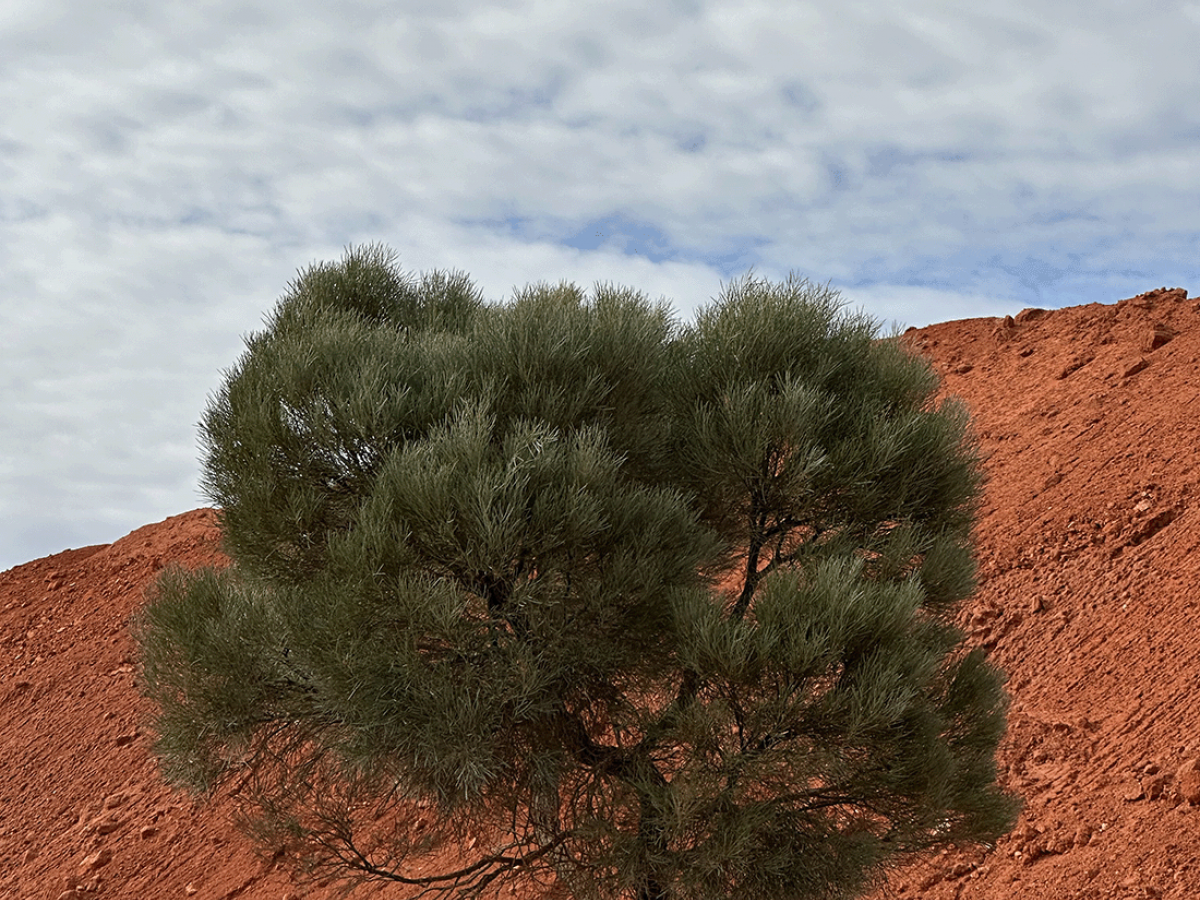Solving the pearl bluebush seed deficit for post-mining revegetation

Immature pearl bluebush seed (photo: Jaclyn Wilmot)
Jaclyn Wilmot is an Honours student at the University of Adelaide, and student affiliate at the Environment Institute under the supervision of Dr Ilaine Matos, Environment Institute member. She is investigating the challenges of restoring of Maireana sedifolia (pearl bluebush), a native shrub critical to post-mining revegetation in South Australia’s arid zone. Jaclyn shares insights into the complexities of pearl bluebush reproduction, the importance of soil nutrients like nitrogen, and the potential of nature-based solutions to support seed production. Her work highlights the value of science-led restoration and the future of sustainable land management in mining landscapes.
Across Australia, approximately 2.5 million hectares of land is under an active mining lease and is susceptible to substantial habitat destruction and degradation. While mining is naturally disruptive, there are sustainable ways to rehabilitate the land after mining. This includes restoring it’s shape, replanting vegetation, and helping to minimise long-term environmental impacts.
Rehabilitation at Jacinth-Ambrosia: not a perfect process
Jacinth-Ambrosia (JA), operated by Iluka Resources Ltd., is an Australian mine that is showcases a strong commitment to sustainable mining. Located 200km northwest of Ceduna in South Australia, JA is the world's largest mine of zircon, a mineral used in building electronics and ceramics. A crucial step in post-mining rehabilitation is collecting seeds to re-establish the vegetation of the area. Although this revegetation method has been successful for many plants, some species do not produce enough seeds for revegetation which poses a significant problem.

The mining 'pit' at Jacinth-Ambrosia (photo: Iluka Resources)

Pearl bluebush at Jacinth-Ambrosia (photo: Jaclyn Wilmot)
Pearl bluebush’s infrequent seeding
At JA, pearl bluebush (Maireana sedifolia) is a native species that has shown very low flowering and seed production. The blueish-grey shrub is indigenous to the arid zones of Australia. Finding viable seeds have been challenging, only 64kg has been collected since 2020. Out of the 289 hectare rehabilitated at JA so far, 200 hectares remain without any pearl bluebush. Reintroducing this species in these areas would require over 32,800kg of seed, an amount that is currently unobtainable.

Pearl bluebush at Jacinth-Ambrosia (photo: Jaclyn Wilmot)
Not just an ordinary shrub, but a dominant species
Since pearl bluebush is the most common native plant at JA, its absence is a major setback for the success of the restored ecosystem. Among other consequences, fauna that rely on pearl bluebush for shelter may not return, and potentially not perform their vital pollination, nutrient cycling, and seed distribution services, preventing the success of the entire ecosystem.
To seed or not to seed: what could be preventing flowering?
While shorter-lived plant species reproduce even when resources are tight, pearl bluebush, which can live for up to 300 years is a little more selective. When conditions aren’t right, it prioritisies survival over reproduction. In the arid zone where it usually grows, water is the main limiting factor. To see if adding water could improve seeding production, an irrigation system was set up around pearl bluebush at JA. But after 6 years of constant watering, not a single harvestable seed appeared. This frustrating outcome was a clear sign that water isn’t the only scarce resource preventing reproduction.
The vital role of nitrogen in flowering
Another resource that’s often in short supply for plants in the arid zone is nitrogen. Plants absorb nitrogen from the soil and is essential for reproduction. Nitrogen is a major component of chlorophyll molecules, amino acids, and proteins all of what are plant needs to both survive and reproduce. It is possible that a lack of nitrogen may be one of the reasons that pearl bluebush isn’t producing many seeds.
Can we fix the seed shortage?
With the help of Iluka Resources, Jaclyn’s team at the University of Adelaide is working to find solutions to the pearl bluebush seed shortage.
The first step in this research is identifying if nitrogen is actually stopping pearl bluebush from flowering. From there, the team are testing to determine whether adding synthetic nitrogen fertilizer could boost flowering and seed production rates
Could facilitation be a natural solution?
Further research is underway to see if western myall trees (Acacia papyrocarpa) and biological soil crusts (a living layer of mosses, lichens, and cyanobacteria) could help improve flowering in pearl bluebush. These organisms support nitrogen-fixing bacteria, which can boost nitrogen content of the surrounding soil. If they do support the reproduction of pearl bluebush, they could provide a more natural solution to increase soil nitrogen levels and consequently, help pearl bluebush’s flowering capacity.

A western myall tree at Jacinth-Ambrosia (photo: Jaclyn Wilmot)
Solving the flowering mystery could be essential for conservation
Discovering the true cause behind the limited flowering of pearl bluebush is key to solving the seed shortage. If nitrogen proves to be the missing piece, a dedicated seed orchard could be established using nitrogen fertilizer or planting alongside incorporated symbiotic nitrogen-fixing species to produce the necessary seed supply. This inisight could support Iluka in meeting the seed requirements , while benefitting post- mining revegetation and conservation efforts across Australia. Solving this flowering mystery has the potential to transform these restoration practices as well as safeguard the future of this valuable native species.

Newsletter & social media
Join us for a sensational mix of news, events and research at the Environment Institute. Find out about new initiatives and share with your friends what's happening.
